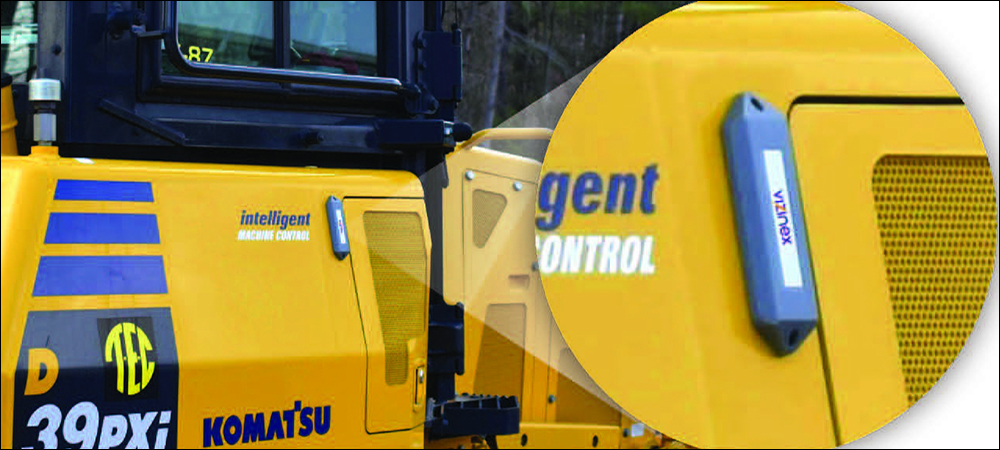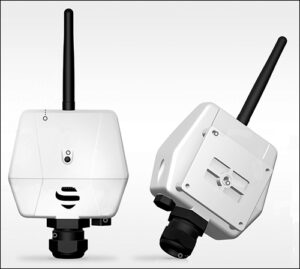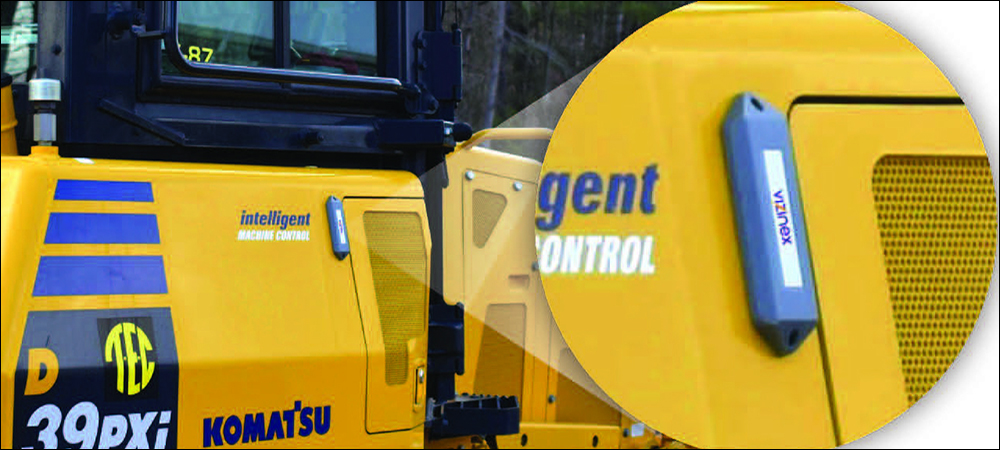Presented here are recent news announcements regarding the following organizations: Siemens, Mojix, Zebra Technologies, Magic Information, STMicroelectronics, Vizinex RFID, XO2Tech, Sewio, the Industrial Internet Consortium, Winbond Electronics and Ambiq.
Siemens Publishes White Paper on Digital Transformation
Siemens reports that manufacturers worldwide are being forced to deal with three megatrends that are imposing major changes. First, globalization is advancing rapidly, turning low-cost manufacturing regions into competitors and giving rise to new sources of goods from low-wage countries. Second, manufacturers must respond to consumers who want and expect to buy products at any time, wherever they may be located, and have them delivered anywhere without delays or errors. And finally, businesses must deal with disruptions to their increasingly global supply chains, caused by the COVID-19 pandemic and other factors.
 These megatrends, according to Siemens, affect all international manufacturers and their logistics providers, which require solutions enabling them to react quickly, with greater flexibility and a high level of execution. Manufacturers need to lower their costs to compete, while at the same time introducing more distinctive or customizable products to meet specific customer needs. They must also produce goods on demand and ensure that these items are delivered to their upstream customers or to the correct stores or warehouses at the right time. Digital transformation, Siemens says, is key.
These megatrends, according to Siemens, affect all international manufacturers and their logistics providers, which require solutions enabling them to react quickly, with greater flexibility and a high level of execution. Manufacturers need to lower their costs to compete, while at the same time introducing more distinctive or customizable products to meet specific customer needs. They must also produce goods on demand and ensure that these items are delivered to their upstream customers or to the correct stores or warehouses at the right time. Digital transformation, Siemens says, is key.
This week, the company released a white paper titled “Digital Transformation: A Guide for Manufacturers,” which explains what digital transformation is and provides clear, feasible and cost-effective steps that manufacturers can take to achieve the flexibility, adaptability and excellence in execution that digital transformation can provide. Locating data, real-time complex event processing and data analytics, the report explains, can enhance a company’s competitive advantage and improve bottom-line results.
Mojix Joins Zebra’s PartnerConnect Program
Mojix, a provider of item-level solutions for the manufacturing, supply chain and retail markets, has announced its participation in Zebra‘s PartnerConnect program as a premier independent software vendor. Through PartnerConnect, Mojix will be able to offer its ytem SaaS-based software solution, which provides real-time visibility across product lifecycles, from raw materials to consumer.
“Working with Zebra allows us to demonstrate our expertise in traceability and the breadth of our capabilities in the wide range of markets Zebra has been nurturing for years,” said Estelle Huynh, Mojix’s chief business operations officer, in a prepared statement. “By coupling Zebra’s industry-leading products with our innovative software applications and ytem platform, we’re helping customers make business-critical decisions to perform their best, whether from a financial, regulatory, or sustainability perspective.”
Joining the PartnerConnect program allows Mojix to engage with customers on a strategic level, the company reports, and to provide a wider range of solutions. The PartnerConnect program is designed to address the needs of distributors, ISVs and resellers. By participating in PartnerConnect, Mojix says it will gain access to Zebra’s portfolio of technology solutions, along with training, marketing, sales and technical benefits.
Magic Information Intros IoT Smart Lock Solution Using ST Tech
Magic Information, a Chinese provider of Artificial Intelligence of Things (AIoT) fingerprint-recognition technology, has launched a smart-lock reference design based on AIoT fingerprint recognition running on STMicroelectronics‘ STM32WB55 Bluetooth Low Energy (BLE) microcontroller. Manufacturers can integrate the reference design into their own designs to make smart locks.
This reference design leverages Arm‘s dual-core Cortex M0+ and M4, designed to provide high interoperability between the hosting MCU, along with fingerprint recognition and BLE 5.2. The fingerprint-recognition algorithm runs on the STM32WB55 MCU, which enables recognition and unlocks the device within 0.3 seconds, according to the company, while providing ultra-low power consumption.
“There is increasing demand for locks that offer completely keyless operation. Restrictions such as power consumption, size, and user experience make these locks extremely challenging to deliver,” said Weiwen Yang, Magic Information’s CTO, in a prepared statement. “The combination of Magic Information’s industry-leading technology in embedded fingerprint recognition running on an STM32WB MCU with BLE meets the challenge. Magic Information will offer a turnkey solution for the whole smart-lock industry. Meanwhile, a platform with APIs for various applications is also available to help our clients develop product/business innovations, with outstanding quality and performance assured.”
“With the BLE 5.2 and outstanding processor performance and power efficiency of the STM32WB running Magic Information’s fingerprint recognition,” added Arnaud Julienne, ST’s VP and head of marketing and applications for the Asia Pacific region, in the prepared statement, “STMicroelectronics their turnkey reference-design solution integrates compactness in system robustness and performance efficiency. Building on the high-level security of the STM32WB, fingerprint recognition enhances the system-level security for markets where it really matters such as access control and medical devices.”
A variety of fingerprint sensors, sizes (including 80 by 64, 112 by 88, 176 by 64, and 160 by 160) and packaging methods are available. The solution, which has been qualified for mass production, is intended to improve efficiency in product building and development, the company reports, as well as shorten time-to-market.
Vizinex RFID Offers Asset-Tracking Tag for Outdoor, Industrial Use
Vizinex RFID, which develops and manufactures RFID tags customized for specific applications, has introduced its XLR tag, which provides a read range of more than 100 feet on metal surfaces. The new tag is designed to allow for a long life in both outdoor and industrial environments, the company reports.
The XLR tag measures 5.28 inches by 1.7 inches by 0.5 inch, with a read range in excess of 100 feet. The sleek, compact tag features rugged packaging, according to the company, and is designed for applications requiring long-range asset identification, such as construction, yard and cargo management, and vehicle and container tracking.

The XLR is designed specifically for mounting on metal, Vizinex notes, but provides a strong read range on virtually any surface. The tag can withstand vibration, weather elements, road salt, harsh cleaning and other environmental challenges for extended periods of time, and it can operate in both the U.S. and ETSI frequency bands, enabling it to be used for tagging assets worldwide.
“The cost-effective XLR tags are designed for accurate and efficient tracking of objects that an RFID reader can’t get too close to, such as cargo containers, large vehicles and construction equipment,” said Ken Horton, Vizinex RFID’s cofounder and CEO, in a prepared statement. “The XLR tags can be read when an object is stationary or moving. We designed the XLR for military asset tracking, yard/fleet management and cargo, container and pallet tracking.”
XO2Tech Unveils RFID Products for Fast-Moving Consumer Goods
XO2Tech has introduced two new RFID products for fast-moving consumer goods (FMCG). The new offerings are known as the RFID Touch Tag and the RFID Conversational Commerce service.
The RFID Touch Tag enables users to receive digital product information and order FMCG items by placing a finger on top of or near the tag attached to a product. A smartphone or reader automatically detects a user’s timed interaction with the tag and uses that data to place a product order or provide information via a link, chat app or app menu, with selectable product categories or other information ranging from a digital product label to traceability data. The tag provides product supply chain and inventory management data and is designed to interact with a voice module to provide conversational or product information, as well as confirm user and product interactions and transactions.
The RFID Conversational Commerce is an AI/voice system designed to integrate RFID tags and sensors attached to FMCG products, or to work or household items. The system uses RFID tag or sensor data to create user conversations with products or brands, and to interact with brands or businesses via voice or messaging and chat apps like Facebook Messenger, WhatsApp, Talk or WeChat. The solution enables brands and businesses to provide unique revenue opportunities, consumer insights, rapid response and service across multiple digital channels.
A reader detects sensor data or a user’s interaction with an RFID-tagged FMCG product and integrates the user, product, sensor and interaction data with voice conversations, AI product recommendations, revenue insights, product feedback or AI-suggested product uses. It can also be used with other inventoried RFID or non-RFID FMCG items. The system provides users, brands and businesses with comprehensive and targeted strategic differentiators to provide user recommendations, insights and revenue opportunities.
Sewio Releases Industrial Anchor for RTLS Deployments
Sewio, a UWB-based real-time location system (RTLS) vendor, has released its Sewio Omni industrial anchor, designed for deployments in complex factory layouts. The anchor is FCC- and CE-certified, the company reports, and can be deployed in any industrial environment. It comes with an IP65 housing, a wide temperature operation range and a protective vent.
 Expanding the in-house manufactured industrial infrastructure portfolio allows for the Sewio RTLS to combine two anchor types (wide range and focused long range) in a single industrial indoor tracking deployment, according to the company. This combination saves on the number of anchors and cabling, the firm reports, and thus decreases project costs while shortening a project’s payback period. Additionally, it makes highly precise localization possible in the non-ideal tag placements scenarios present in industrial environments.
Expanding the in-house manufactured industrial infrastructure portfolio allows for the Sewio RTLS to combine two anchor types (wide range and focused long range) in a single industrial indoor tracking deployment, according to the company. This combination saves on the number of anchors and cabling, the firm reports, and thus decreases project costs while shortening a project’s payback period. Additionally, it makes highly precise localization possible in the non-ideal tag placements scenarios present in industrial environments.
“The Sewio Omni anchor is the latest addition to our hardware portfolio and we are truly proud to have both the Vista Omni and Vista DirectFive anchors certified by FCC and RED/CE with a high-grade certification compliance,” said Lubomír Mráz, Sewio Networks’ CTO, in a prepared statement. “This is definitely a step in the right direction towards opening up new possibilities of deployments in harsh industrial environments for our customers.”
Sewio Networks’ RTLS solution is designed for indoor tracking in the intralogistics, retail, sports, entertainment and livestock industries. The system is built on ultra-wideband technology and comes with RTLS Studio, remote management and visualization software.
Industrial Internet Consortium Launches IoT Patterns Initiative
The Industrial Internet Consortium (IIC) has announced its IIC IoT Patterns Initiative to crowdsource, review, revise and publish a library of IoT patterns for use and reuse across industries. A pattern describes a recurring design or architectural problem in a specific context and offers an established scheme for its solution.
IoT patterns include architectural designs to represent essential cohesive components and their assembly, as well as design patterns that illustrate solutions to specific problems. IIoT developers and system architects can access the IIC IoT Patterns repository on the IIC Resource Hub. Developers can join the IIC Community Forum to discuss patterns, and workshops to educate the IIoT developer community will be announced.
“Patterns capture and condense teachings from developer and system architect experiences that others can use to tackle new problems,” said François Ozog, the director of Edge & Fog Computing Group—Linaro and a co-chair of the IIC Patterns Task Group, in a prepared statement. “The IIC is also developing application notes to describe how to use patterns effectively in various contexts and to help identify the best patterns for solutions.”
Use cases describe various perspectives of a system based on user roles, by defining user requirements and identifying essential functionalities. “Many patterns are technical,” added Daniel Burkhardt, a doctoral student at the Ferdinand-Steinbeis-Institut and a co-chair of the IIC Patterns Task Group, in the prepared statement. “But by focusing on end-user concerns and requirements, developers and system architects will use patterns effectively, and solution designs will improve.”
Winbond, Ambiq Partner on IoT Solutions, Wearables
Winbond Electronics, a supplier of semiconductor memory solutions, and Ambiq, a provider of ultra-low power microcontrollers, systems-on-chip and real-time clocks, are collaborating to combine HyperRAM and Apollo4 to deliver ultra-low-power solutions for IoT endpoints and wearables. Several customers are currently in design with Ambiq’s Apollo4 SoC and Winbond 256Mbx8 HyperRAM Hybrid Sleep Mode (HSM), with volume production expected in 2022.
The emergence of artificial intelligence and innovations in battery-powered endpoint devices is driving the recent IoT market’s rapid growth, according to the companies. The benefits of having everything connected to enable human communications and facilitate human-machine interactions are primarily evident in the smart-home industry. The Apollo4 hardware and software solution allows battery-powered endpoint devices to achieve greater intelligence without sacrificing battery life, the partners explain. Adding HyperRAM can further enhance its low power advantage, they note, and allow for faster delivery of high-resolution graphics to improve the performance.
“As the IoT market rapidly expands with the proliferation of diverse mobile and portable devices, how to deliver the most desirable user experience becomes the holy grail for manufacturers,” said Dan Cermak, Ambiq’s VP of architecture and product planning, in a prepared statement. “Built on Ambiq’s patented Subthreshold Power Optimized Technology (SPOT) platform, the Apollo4 delivers higher performance at ultra-low power consumption. Leveraging Winbond’s HyperRAM to enable expanded storage to support high-resolution displays and complex AI datasets, we can deliver low-power solutions while maintaining low pin count for smaller form-factor endpoint devices.”
A2B Tracking, Fetch Robotics Team Up on RFID Solutions
A2B Tracking has announced that it has been recognized as a certified solution partner for Fetch Robotics. This partnership will allow A2B Tracking to integrate Fetch Robotics’ TagSurveyor RFID-enabled Automated Mobile Robot (AMR), along with its FetchCore cloud-based software platform. This certification enable’s A2B’s RFID platform to operate with the Fetch TagSurveyor and FetchCore platform in a multitude of environments and use cases, such as autonomously tracking the identities and locations of assets, as well as performing autonomous inventory counts.
“The Fetch Certified Solution Partner designation is a real honor,” said Peter Collins, A2B Tracking’s founder and CEO, in a prepared. “Their endorsement of our RFID Asset Management platform and the successful integration with the Fetch TagSurveyor system is very exciting.” The Fetch TagSurveyor combines AMR technology with RFID to provide continuous cycle counting and inventory tracking. Fetch AMRs move throughout a warehouse to provide consistent and reliable results, the company explains, eliminating the need for manual counting and the potential for human error.
TagsSurveyor AMRs can be set up to run autonomously 24 hours a day, freeing up workers from cycle counting and allowing them to perform other work. Conformance with ANSI/RIA R15.08 ensures that Fetch AMRs meet safety standards for industrial mobile robots, the companies report. “The integration of the Fetch TagSurveyor and the A2B Tracking RFID platform is making a huge impact on organizations by providing complete asset visibility without adding people,” added Joe Lau, Fetch Robotics’ head of channels, in the prepared statement.


